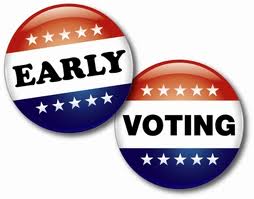Tomorrow we start voting – well, technically, tomorrow we start voting in person. People have already been sending in mail ballots, as we’ll see when the Day One EV totals are posted. I will of course report on this as we go along, but to get us started, here’s a look back at the early voting data from the last two city elections, in 2019 when Mayor Turner had to fight off several challengers, and in 2015 when Turner prevailed over a large field to succeed Mayor Parker. The final EV totals from 2015 are here and from 2019 are here, and I’ll refer to those as I post the daily EV numbers for this yeaer. The final EV totals from 2013 are here. I don’t plan to include those in my daily reports, but I’m posting them here for reference.
One thing to note before we go any further is that the daily EV numbers for this year and all of those final EV numbers above are for all of Harris County. That means that some of them are not for the city of Houston elections. Also, there are some Houston voters in Fort Bend (a few thousand) and Montgomery Counties (a few dozen). I don’t track them, mostly because I don’t get the daily EV totals sent to me. Every time I refer to “Houston” below, I am referring to the share of Harris County voters that are in Houston.
Okay. The numbers, please:
Total early votes
Year Mail Early Total
==============================
2015 29,859 164,104 193,963
2019 15,304 137,460 152,764
Ballots mailed and returned
Year Mailed Returned Percent
===============================
2015 43,280 29,859 69.0%
2019 26,284 15,304 58.2%
Houston EV share
Year Hou EV HarrisEV Hou Pct
===============================
2015 134,105 197,783 67.80%
2019 109,144 158,029 69.07%
Houston EV rate
Year Early Total EV Pct
===============================
2015 134,105 268,874 49.88%
2019 109,144 244,979 44.55%

The first table is just the early votes by type. In 2015, mail ballots were 15.4% of all early votes, while in 2019 that was 10.0% of the total. Do remember that the 2015 election also included the anti-HERO referendum, and that drove a certain amount of turnout, which included mail ballots. My guess for this year is that the mail ballot share will be between these two numbers, probably closer to the 2019 level.
“Ballots mailed and returned” means what it says, the percentage of mail ballots that had been sent to those who requested them and who returned them. Again, the 2015 anti-HERO vote likely drove a lot of the interest here, both for requested and returned ballots. Remember that some number of mail ballots get returned on the Monday and Tuesday after early voting, so the final mail ballot total is higher than what you get in the daily EV reports.
“Houston EV share” is the percentage of the early vote in Harris County that came from Houston. There was a Metro referendum in 2019, and four Harris County referenda, one of which was a Harris County flood control proposal, on the ballot as well those years. I’m actually a little surprised that the Houston share of the vote was smaller in 2015 than in 2019, but overall it’s not that much different. Expect the Houston share of the vote to be in this range this year as well.
Finally, the “Houston EV rate” is the share of all Houston votes that were cast early, including mail ballots. Those numbers are almost shockingly small, especially in comparison to the EV shares we see in even-numbered years, where it’s well over 80% for Presidential elections. I expect this to be higher this year just because the trend is generally in that direction, but this is a reminder that historically, the people who vote in odd-numbered years, mostly city of Houston voters, still like voting on Election Day. Don’t be alarmed if the early vote totals are not as robust as you might think they’d be because of this.

Pingback: November 2023 Day Three EV totals: All in person | Off the Kuff